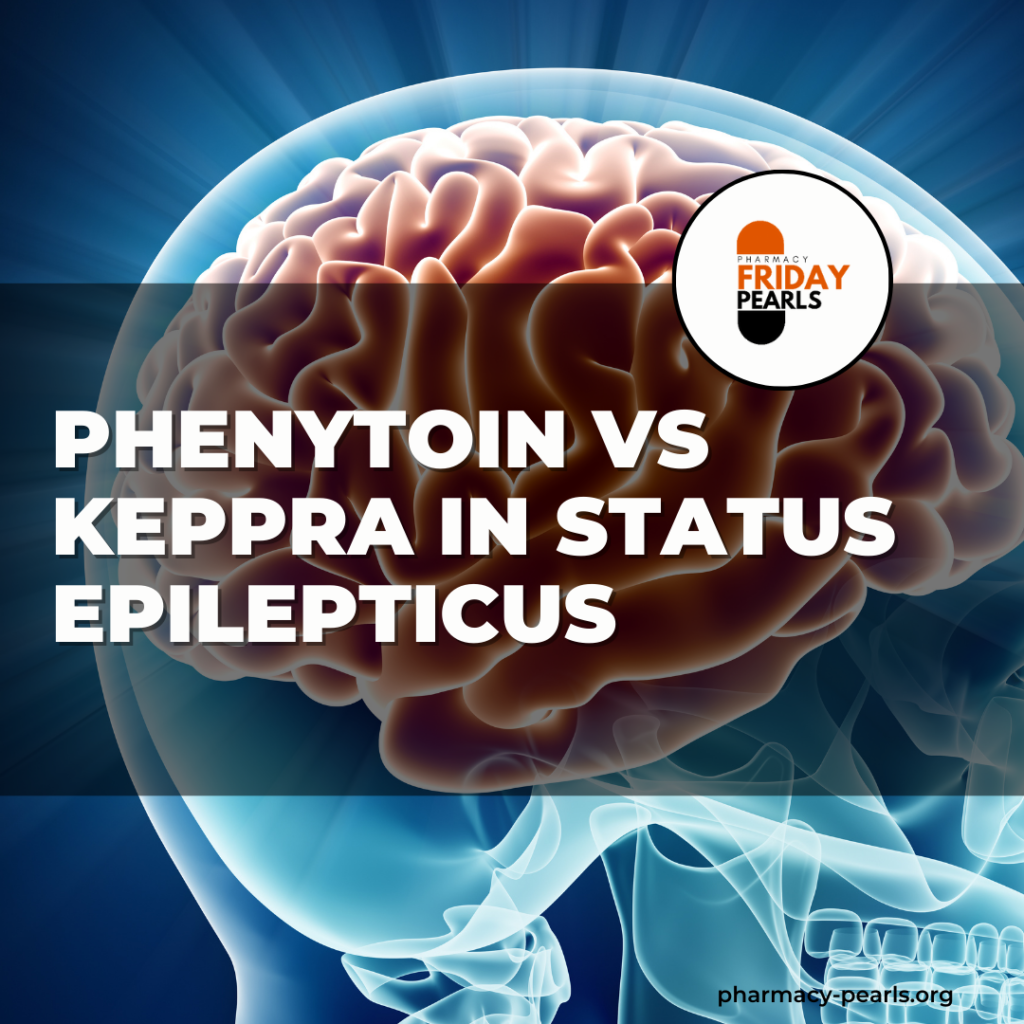Fosphenytoin vs Keppra for Status Epilepticus

Introduction
- Status epilepticus is a neurological emergency that required urgent assessment and treatment with pharmacologic agents
- Lorazepam and diazepam are short-acting drugs that can produce immediate effects.
- Treatment with another long-acting anticonvulsant drug is necessary to prevent recurrent convulsions.
- Use of IV phenytoin (PHT) in the treatment of status epilepticus dates back to the 50s with fosphenytoin (FPHT) being the primary agent in some institutions.
- However, both PHT and FPHT can induce adverse reactions such as a reduction in blood pressure, arrhythmia, and allergic symptoms.
Pharmacology
| Properties | Phenytoin/ Fosphenytoin | Levetiracetam (Keppra) |
| Dose | 20 mg/kg/PE (max 1500 mg) | 1-4.5 g IV (40-60 mg/kg)* |
| Administration | Max IV fusion PHT 50 mg/min FPHT 150 mg/min | 1g IV Push ~2 min** 1.5-2g IV over 7 min** (2-5 mg/kg/min) |
| Formulation | IV/PO | IV/PO |
| PK/PD | Onset: ~30 min*** Half Life: 12-28 hr Excreted: >90% in urine | Onset: 30-45 min Half-life: 6-8 hr Excreted: 66% renal |
| Adverse Effect | Phlebitis, hypotension, bradycardia & dysrhythmias | Abnormal behavior Dizziness Irritability |
| Drug Interactions and warnings | Major CYP3A4 Inducer (↓ drug levels) | —– |
| Compatibility | PHT – only D5W FPHT- D5W or NS | D5W or NS |
*GHS has utilized this administration based on clinical experience
**PE= Phenytoin equivalents
** Fosphenytoin takes 15 mins to be metabolized to active metabolite in addition to the infusion time
Overview of Evidence
| Author, Year | Design/ sample size | Dosing regimen | Outcome |
| ESETT | RCT N= > | VPA 30 mg/kg (max 3000 mg) vs LEV 60 mg/kg (max 4500mg) vs PHT 20 mg/kg (max 1500 mg) | Result expected 2020 |
| Nakamura, 2017 | *Respective analysis/ n=63 | LEV 1000 mg vs FPHT 22.5 mg/kg | No difference in control of seizure(81 vs 85.1%, p=0.69), adverse effects, or transition to PO antiepileptic drug |
| Gujjar et al, 2017 | *Prospective, open-label trial/ n=52 | LEV 30 mg/kg vs PHT 20 mg/kg | LEV displayed no statistically significant difference than PHT in SE Sequential use of these 92–97% of case controlled without anesthetic agents. |
| Chakravarthi, 2017 | *RCT n=44 | LEV 20 mg/kg vs PHT 20 mg/kg | Both LEV and PHT were equally effective at termination of seizure activity within 30min and recurrence of seizures within 24 hours |
| Mundlamuri, 2015 | RCT/ n=150 | VPA 30 mg/kg vs LEV 25 mg/kg vs PHT 20 mg/kg | No statistically significant difference in control of SE between VPA (68%), PHT (68 %,) and LEV (78%). |
| Alvarez et al, 2011 | Retrospective analysis/ n=466 | VPA 20 mg/kg LEV 20 mg/kg PHT 20 mg/kg | VPA controlled SE in 74.6%, PHT in 58.6% and LEV in 51.7% of episodes LEV failed more often than VPA [odds ratio (OR) 2.69 |
References
- Phenytoin. Micromedex [Electronic version].Greenwood Village, CO: Truven Health Analytics. Retrieved November 12, 2018, from http://www.micromedexsolutions.com/
- Levetiracetam. Micromedex [Electronic version].Greenwood Village, CO: Truven Health Analytics. Retrieved November 12, 2018, from http://www.micromedexsolutions.com/
- Alvarez V. Second-line status epilepticus treatment: comparison of phenytoin, valproate, and levetiracetam. Epilepsia. 2011 Jul;52(7):1292-6.
- Chakravarthi S. Levetiracetam versus phenytoin in management of status epilepticus. J Clin Neurosci. 2015 Jun;22(6):959-63.
- Mundlamuri RC. Management of generalised convulsive status epilepticus (SE): A prospective randomised controlled study of combined treatment with intravenous lorazepam with either phenytoin, sodium valproate or levetiracetam–Pilot study. Epilepsy Res. 2015 Aug;114:52-8.
- Gujjar AR. Intravenous levetiracetam vs phenytoin for status epilepticus and cluster seizures: A prospective, randomized study. Seizure. 2017 Jul;49:8-12.
- Nakamura K. Efficacy of levetiracetam versus fosphenytoin for the recurrence of seizures after status epilepticus. Medicine (Baltimore). 2017 Jun;96(25):e7206
- Bleck T. The established status epilepticus trial 2013. Epilepsia. 2013 Sep;54 Suppl 6:89-92.

Responses